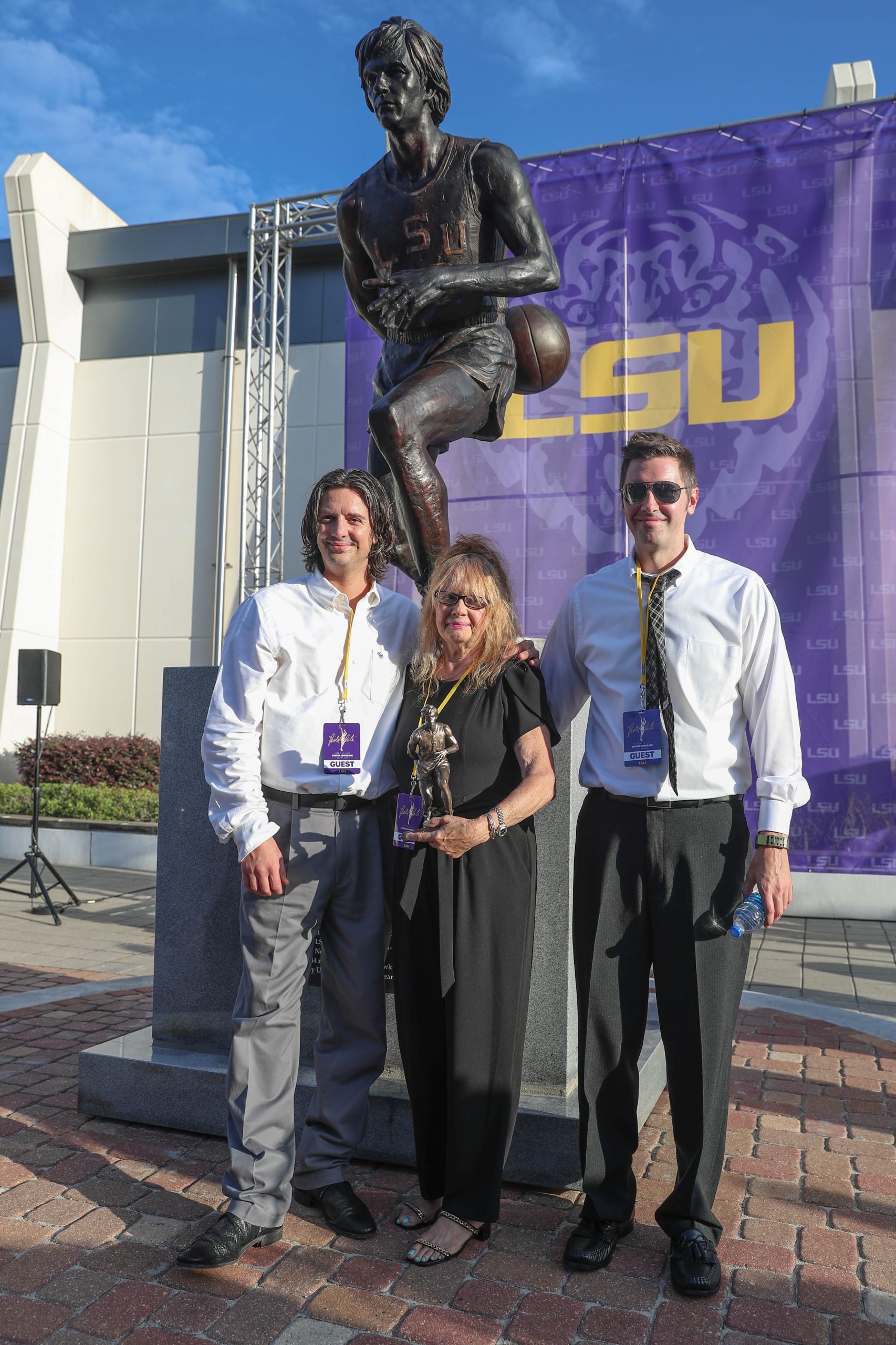
Brian Hanlon has sculpted iconic figures from throughout American sports history.
Georgetown basketball coach John Thompson. Keith Jackson at the Rose Bowl. Evander Holyfield in Atlanta. Auburn’s Charles Barkley. Jim Brown at Syracuse.
The list goes on and on, including LSU’s Skip Bertman, Billy Cannon, Bob Pettit and – captured in an iconic mid-dunk moment – Shaquille O’Neal in Baton Rouge.
But when Hanlon was commissioned to produce the Pistol Pete Maravich statue unveiled July 25 at LSU, the subject matter held special meaning for the nationally renowned Toms River, New Jersey, sculptor.
“This is more personal out of the five (LSU) statues as a result of me being 61 years old, and, as a kid, wearing floppy socks on purpose, and wanting to be Pistol Pete Maravich,” said Hanlon, dubbed the “Sports Rodin” by the New York Times in 2018 for his work in the sports entertainment sector.
“Your dream would be to score (44.2) points per game,” added Hanlon, referencing Maravich’s LSU career scoring average. “But a very inspiring gentleman, I think, off the court too. … If young people took the time to read about him, they would see more than statistics.”
Maravich scored 3,667 points in three seasons at LSU, averaging 44.2 points per game starting with the 1967-68 season.
His totals still stand as school and NCAA records today, despite a ban at the time on freshmen playing varsity basketball and the absence of a three-point line and shot clock during Maravich’s college career.
Hanlon originally had one look in mind for portraying the 6-foot-5 shooting guard.
“Why wouldn’t you sculpt him shooting?” Hanlon, also the official master sculptor for the Naismith Memorial Basketball Hall of Fame, told Tiger Rag. “I mean, this is the greatest shooter in the history of the game.”
Maravich’s two sons, Jaeson and Josh, had a different idea: “They said, ‘No. My dad was ‘The Show.’ You have to sculpt him throwing the ball behind his back.’ ”
So Hanlon did just that, capturing one of Maravich’s memorable passing moves – flicking the ball with his right hand behind his back – for a statue that wasn’t unveiled until six years after being approved unanimously by the LSU Board of Supervisors.
Long overdue in the eyes of some, it now stands alongside existing statues of O’Neal and Pettit on the north side of the LSU arena bearing the Maravich name.
The Louisiana Legislature renamed the venue the Pete Maravich Assembly Center in 1988, shortly after Maravich, who had previously undetected heart issues, died playing pickup basketball in California.
An LSU official earlier this year cited uncertainty over future PMAC renovation plans and the COVID-19 pandemic as reasons for the delay in the statue’s placement and unveiling.
Others suspect the fact Maravich never graduated from LSU played a part.
“Killing me. Killing me. Killing me,” Hanlon said of it taking so long.
“Pete is quite misunderstood in that as a young man he had a learning disability, and those things weren’t identified back then. So, for him to be, I think, slighted because he wasn’t able to read like you and I – I mean, he was reading backward; his dyslexia – is a little unfair.”
For several years the statue resided outdoors – weather-beaten, and unseen by public eyes – at a New Orleans-area storage facility.
Complicating matters, the back of its base was damaged upon delivery at LSU.
“For many, many different reasons it just got put on hold,” Hanlon told Tiger Rag Radio, “and by the time we were ready to install it … we had found out it wasn’t being stored very professionally. “Both the base and the sculpture had aged a little bit, so (we) spent 12 hours redoing the surface of the statue the night before (the unveiling).”
Hanlon spent 12 hours on a ladder making fixes, with assistance.
He’s thrilled, though, to finally share what he created.
“His basketball prowess – I don’t know if you can say the word genius, but – it’s certainly brilliant, on the level of all the greats of all-time,” he said. “So this is one I always wanted to do.”
Maravich – inducted in 1987 into the Naismith Hall of Fame – was the 1970 Naismith Award
winner, Sporting News’ National Player of the Year and a three-time first team All-American.
He also was a five-time NBA All-Star during a 10-season, knee injury abbreviated pro career that included time with the Atlanta Hawks, the New Orleans and Utah Jazz, and the Boston Celtics, and he’s on, as are O’Neal and Pettit, the NBA’s 50th and 75th Anniversary All-Time Teams.
“Over Pete’s lifetime many have described him as an entertain- er, an artist, a showman, basketball assassin, wizard, genius or one-of-a-kind,” his widow Jackie said. “Every time a family member meets someone and they find out Pete was a relative, they immediately have a smile and have a story about a memory of watching Pete play … and the thrill of seeing him perform his magic with a basketball.”
Someone, that is, much like a sculptor from Jersey named Brian Hanlon.
“My first love was basketball as a kid, and my nickname in HYAA community basketball was ‘Pistol Pete,’ ” said Hanlon, raised in Holmdel, New Jersey. “I scored … like, low 20s a game, so I got the title of ‘Pistol Pete.’ “

Be the first to comment